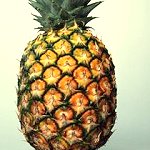|
|
|
Pineapple Fruit Facts Page Information
|
Availability by variety
|
 Pineapple, common name for a flowering plant family, characterized by unique
water-absorbing leaf scales and regular three-parted flowers. The leaves are
spirally arranged sheaths or blades, usually occurring in layers. The plant
embryos have one seed leaf (see Monocots). The family, which contains more
than 2000 species placed in 46 genera, is almost exclusively native to the
tropics and subtropics of America, with one species occurring in western
Africa. Many species are now cultivated around the globe, however. The most
economically important species is the familiar pineapple. A few species are
sources of fiber; others are cultivated for their showy flowers or foliage.
The family constitutes an order, and the term bromeliad is used for its members.
Pineapple, common name for a flowering plant family, characterized by unique
water-absorbing leaf scales and regular three-parted flowers. The leaves are
spirally arranged sheaths or blades, usually occurring in layers. The plant
embryos have one seed leaf (see Monocots). The family, which contains more
than 2000 species placed in 46 genera, is almost exclusively native to the
tropics and subtropics of America, with one species occurring in western
Africa. Many species are now cultivated around the globe, however. The most
economically important species is the familiar pineapple. A few species are
sources of fiber; others are cultivated for their showy flowers or foliage.
The family constitutes an order, and the term bromeliad is used for its members.
The pineapple was probably first domesticated in the high plateaus of central
South America; it was widely planted for its fiber before Europeans first saw
it in the Caribbean. Thereafter, cultivation spread to warm regions around the
globe. Hawaiian plantations produce almost a third of the world's crop and
supply 60 percent of canned pineapple products. Other leading producers are
China, Brazil, and Mexico.
In California, Pineapples are available all year. A ripe Pineapple is fragrant,
heavy and symmetrical in size. In the USA, pineapples are enjoyed as a dessert
or snack, in salads, in drinks, in baking and in cooking. Once the fiberous
core is removed and the fruit seperated from the shell, delicious and juicy
slices can be carved from the remaining flesh. Pineapples are picked ripe and
ready to eat, so you can enjoy them immediately after purchase.
Basic Nutritional Facts: Fat-free, Saturated fat-free,Very low sodium,
Cholesterol-free, High in vitamin C
Detailed nutritional informatin can be found by searching the
USDA Nutritional Database
. Enter "Pineapple" (no quotes) as the keyword and select the link
and report of interest.
Scientific classification:
Pineapples make up the family Bromeliaceae and the order Bromeliales.
The familiar pineapple is classified as Ananas comosus. The primitive
pineapples that grow high in the Andes are classified in the genus Puya.
Spanish moss is classified as Tillandsia usneoides.
|
|